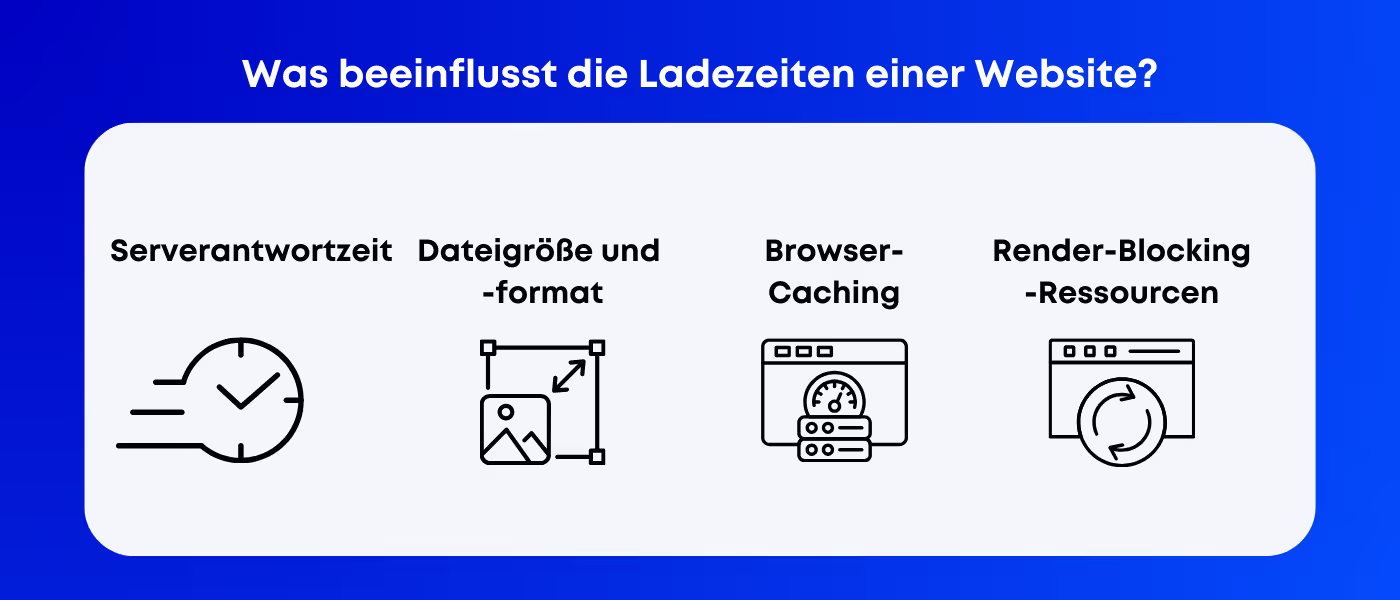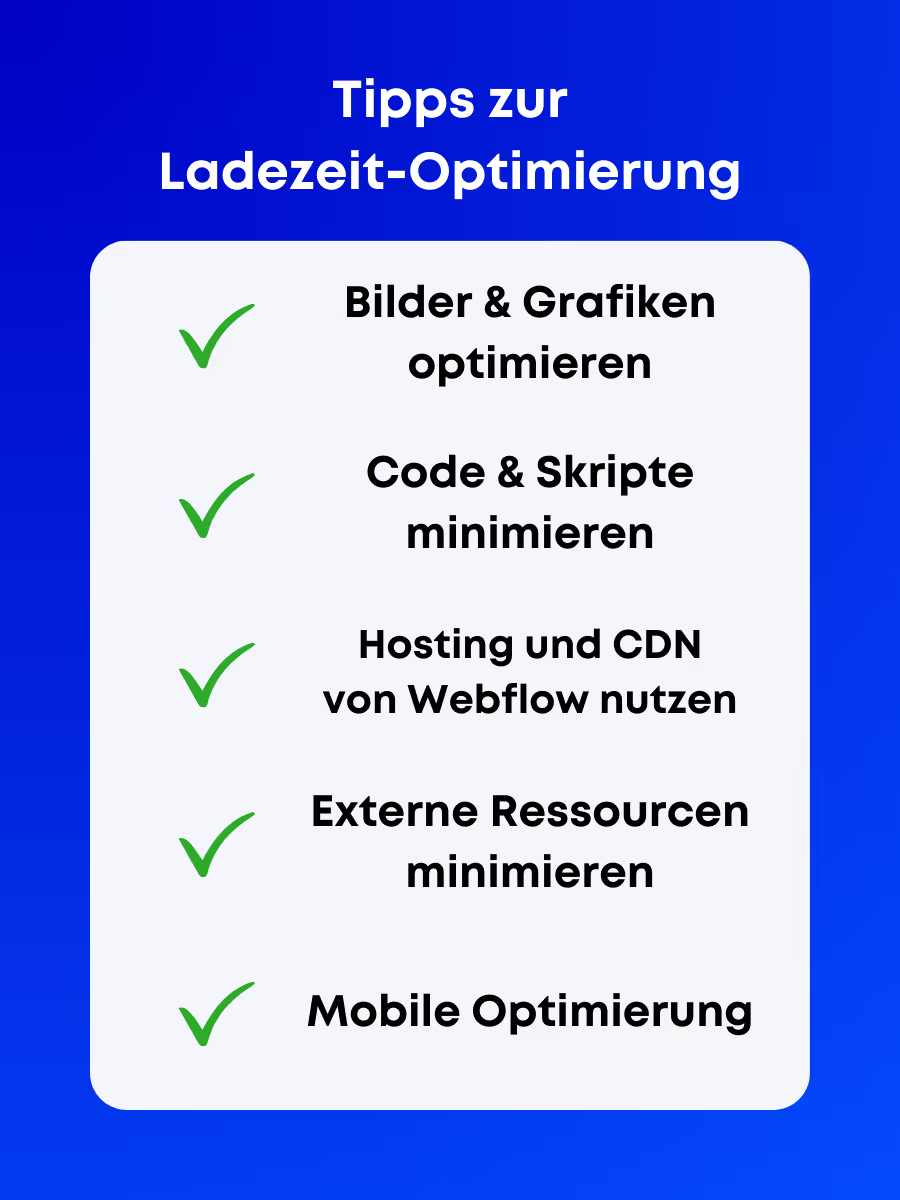The importance of fast load times
The speed of a website is more than just a convenience feature; it is a decisive factor for success in online business. Optimized loading times are essential for companies and self-employed people who want to remain present and competitive on the Internet. Here, we'll show you how to improve your website speed using Webflow, an advanced web design tool.
Fast loading times are crucial for a number of reasons:
- User experience: Nowadays, website visitors expect fast loading times. A delay of just a few seconds can result in potential customers leaving their site and switching to the competition.
- Search engine optimization (SEO): Google and other search engines consider load time as a ranking factor. Faster websites tend to rank better in search results.
- Conversion rates: Faster load times result in higher conversion rates. Whether it's sales, signing up for newsletters, or downloads, speed plays an essential role in user decision-making.
Why Webflow
Webflow offers a unique combination of flexibility, control, and simplicity that makes it ideal for companies and self-employed people who want to optimize their web presence without deep technical knowledge. As a visual web design tool, it allows you to create professional-looking websites while considering the technical aspects of website performance.
With Webflow, you can:
- Create intuitive and visually appealing designs.
- Customize and optimize your website in real time.
- Get access to advanced SEO tools that help your website rank better in search engines.
- Benefit from integrated hosting that's built for speed and security.
Basics of website performance
Before we dive into the specific methods for optimizing load times with Webflow, it's important to develop a basic understanding of the factors that influence a website's performance. This knowledge is critical to taking the right action and ensuring a fast, seamless user experience.
What influences the loading times of a website?
The loading time of a website is determined by a variety of factors, many of which operate in the background. Here are a few key elements:
- Server response time: The time it takes a server to process a request before any data is even sent is essential. A powerful hosting service can make significant improvements here.
- File size and format: Large files, particularly images and videos, can significantly slow down loading times. Optimizing and compressing these files is essential.
- Browser caching: Caching allows the browser to save specific resources so they don't have to be reloaded on future visits.
- Render blocking resources: Certain resources, such as CSS and JavaScript, can block the page from rendering until it is fully loaded.

The role of website speed in SEO and user experience
Search engines like Google use load time as a ranking factor. Faster websites tend to rank higher in search results. This is because search engines value the user experience and fast load times help ensure a positive experience.
user experience
User experience (UX) is of paramount importance today. Sites that load quickly keep users on the page longer, improve usability, and encourage positive associations with your brand.
Optimized website performance is crucial not only for usability, but also for visibility in search engines. In the next chapter, we'll look at how Webflow can specifically help improve these aspects by focusing on specific features and techniques available in this powerful tool.
Optimize with Webflow
Webflow is an intuitive, visual modular system for web design and development that offers a high level of flexibility without the need for in-depth programming knowledge. It combines the simplicity of an editor with the power of a full-fledged content management system (CMS), making it an excellent choice for companies and self-employed people who want to build and manage a professional web presence.
Webflow's special features in terms of website performance
- Visual design and code minimization: Webflow generates clean, optimized code in the background while you focus on designing. This means less redundant or redundant code, which results in faster load times.
- Responsive design: Webflow allows you to create designs that work well on different devices and screen sizes without the additional effort required to customize. A responsive design is not only good for the user experience, but also improves loading times on mobile devices.
- Image and asset management: Webflow provides tools for easy image optimization, including automatic scaling and compression, to reduce the size of your assets without sacrificing quality.
- Hosting and Content Delivery Network (CDN): Webflow uses global hosting and a CDN to deliver your content faster to users worldwide. This significantly reduces server response times and improves the overall speed of your website.
A key advantage of Webflow is that optimization starts in the design process. You have control over the number and type of elements that appear on your page, so you can ensure high performance right from the start.
Practical tips for optimizing load time in Webflow
A fast and responsive website is critical to gaining visitors' attention and trust. With Webflow, you have the tools to specifically improve the performance of your website. Here are some practical tips that you can implement right away to optimize your website's load times in Webflow.
1. Optimize images and graphics
Images are often the biggest data elements on a website. Optimize them to reduce load times:
- Compress images: Use Webflow's built-in image compression features or external tools to reduce file size without loss of quality.
- Choose the right format: JPEGs are good for photos, PNGs for graphics with few colors and transparencies, and SVGs for vectors.
- Responsive images: Make sure your images are optimized for different screen sizes.
2. Minimize code and scripts
Excessive or unused code can slow down your site. In Webflow, you can:
- Use only necessary fonts: Limit yourself to essential fonts and font styles.
- Optimize JavaScript: Avoid excessive use of JavaScript and remove unnecessary scripts.
- Use the clean-up function: Webflow provides a function to remove unused classes and clean up the CSS code.
3. Use Webflow hosting and CDN
Webflow offers hosting solutions that are specifically designed for high speed and reliability:
- Use Webflow Hosting: Benefit from fast load times and a high level of security.
- Use CDN: Webflow's Content Delivery Network (CDN) distributes your content globally to reduce load times.
4. Minimize external resources
Reduce the number of external requests:
- Limit plugins and widgets: Any additional tool can increase loading time.
- Check external fonts and icons: Make sure that external fonts and icons are really necessary and don't interfere with loading time.
5. Mobile optimization
Mobile users are an essential part of your audience:
- Responsive design: Make sure your website works well on mobile devices.
- Optimize touch elements: Adjust the size and placement of touch elements to ensure ease of use.
By applying these tips to Webflow, you can significantly improve your website's load times. Remember that every second counts when it comes to keeping and converting visitors.

Summary and outlook
- Design images efficiently: Optimizing image sizes and formats is essential for fast loading times.
- Minimize code and scripts: Clean, minimized coding helps speed up your site.
- Use Webflows hosting and CDN: These services are designed to deliver your content quickly and reliably.
- Consider mobile optimization: A fast mobile version of your website is essential for a good user experience.
Future trends and developments
With regard to the future of web development and performance optimization, companies and self-employed people should keep the following points in mind:
- Development of technologies: The continuous development of web design tools and technologies will offer further opportunities to optimize loading times.
- Growing importance of mobile-first: With an increasing share of traffic on mobile devices, mobile performance is becoming increasingly important.
- Artificial intelligence in web design: AI-based solutions could revolutionize the design and optimization of websites in the future.









Recommend this post